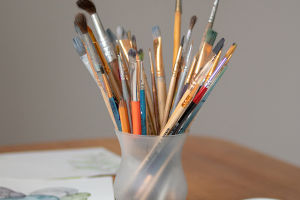We all have days when our minds won't quiet down—when we feel restless, overwhelmed, or just not quite ourselves. During those moments, have you ever picked up a pen or pencil and started to doodle?
We have. And surprisingly, even that small act can bring a sense of relief. Drawing may seem simple, but for many of us, it's becoming a powerful way to manage stress and anxiety.
Drawing as a safe space
When we draw, we create a space where we don't need to explain ourselves. No pressure, no rules—just lines, colors, and shapes that help us let go. According to Dr. Cathy Malchiodi, a leading expert in art therapy, creative activities like drawing can help the brain shift out of "fight or flight" mode and into a calmer state. That means we're not just passing time—we're helping ourselves reset.
Why it works for our minds
Drawing helps in more ways than we might expect. First, it slows us down. When we focus on sketching a flower or shading a face, we start breathing more steadily. Our thoughts stop racing. It's a bit like meditation—but instead of sitting still, we're moving our hands. Second, drawing gives us control. In a world where so much feels unpredictable, putting marks on paper helps us feel grounded.
We don't need to be "good" at it
Let's be honest—some of us hesitate because we think we're not artistic enough. But this isn't about making a masterpiece. It's about how the process makes us feel. Even simple doodles or repeating patterns can be enough to calm our nerves. In fact, a 2016 study found that 45 minutes of making any kind of art—no matter the skill level—can lower stress hormones in the body.
Different ways to draw for calm
There are many ways we can use drawing to ease anxiety:
1. Free drawing: Grab a pencil and just draw whatever comes to mind—shapes, faces, animals, or pure randomness.
2. Mandalas or patterns: Drawing repeated shapes can be especially soothing.
3. Visual journaling: Mix words and pictures to capture your day or your mood.
4. Guided drawing apps: Try apps like "Lake" or "Pigment" with relaxing prompts and coloring pages.
The key is to focus on the process, not the result.
Helping us understand ourselves better
Sometimes, we can't put our feelings into words—but we might be able to draw them. When we do, we're actually giving our emotions a form we can see and work with. That can lead to helpful insights. What are we avoiding? What are we holding on to? Drawing helps us gently explore those questions without forcing ourselves to explain everything out loud.
Art therapy as real support
More and more mental health professionals are incorporating art into their therapeutic approach. Drawing, for instance, has been shown to support people in coping with anxiety, trauma, and depression. In these sessions, trained art therapists help individuals express their thoughts and emotions through visual creation.
This process can be particularly valuable for those who find it difficult to open up through conventional conversation-based therapy.
Making it part of our daily routine
We don't need a fancy setup to make drawing a habit. Just a small notebook, some colored pens or pencils, and a few quiet minutes each day can do the trick. It might help to create a routine—maybe drawing in the morning before the day begins, or sketching at night to wind down. Over time, we might notice we feel more balanced and in tune with ourselves.
Let's draw through it
So the next time anxiety shows up, let's try something different. Instead of scrolling or overthinking, let's pick up a pen and draw for ten minutes. Let our hands move without a plan. Let our minds breathe. Whether it's a tiny doodle or a full page of color, the goal isn't to impress anyone—it's to reconnect with ourselves.
Have you tried drawing to calm down?
We'd love to hear your story. Have you used art to manage stress or get through a tough time? What helped you most—colors, patterns, or free drawing? Let's talk about how we turn everyday tools like pens and paper into small acts of healing. Because sometimes, a simple sketch can speak louder than words.


